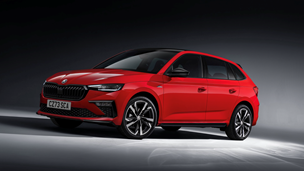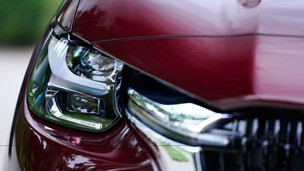So, Toyota is launching a new Qashqai-rivalling crossover into a marketplace overrun with SUV niches. Is there much you really need to know? Well, yes actually.
The new Toyota C-HR is a new addition to Toyota's hybrid garage, although a standard petrol model is available as well.
It's exterior looks as if it has been chiselled from one solid piece of metal, with angular shapes and lines scattered about the place. It actually looks extremely close to its original concept sketch - which in the fashion-conscious crossover segment is always a bonus.
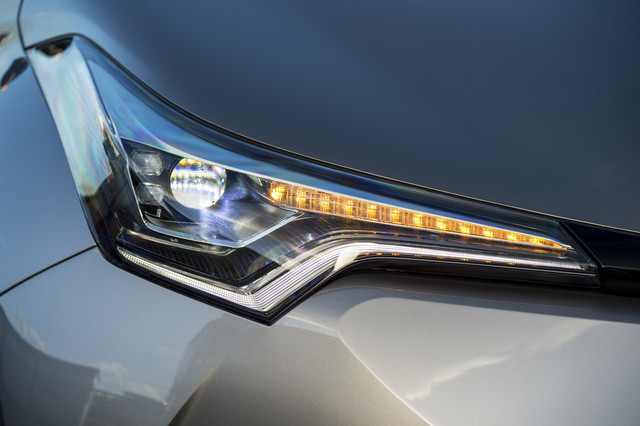
The underpinnings are what make the C-HR significant though, as it incorporates the Toyota New Global Architecture (TNGA), used in the fourth-gen Prius, which Toyota stresses is less of an interchangeable platform and more of an engineering philosophy.
With its SUV crossover stance, the C-HR goes up against the likes of the Nissan Qashqai and Renault Kadjar, although it thinks buyers of premium SUVs like the BMW X1 and Mercedes GLA may also be tempted.
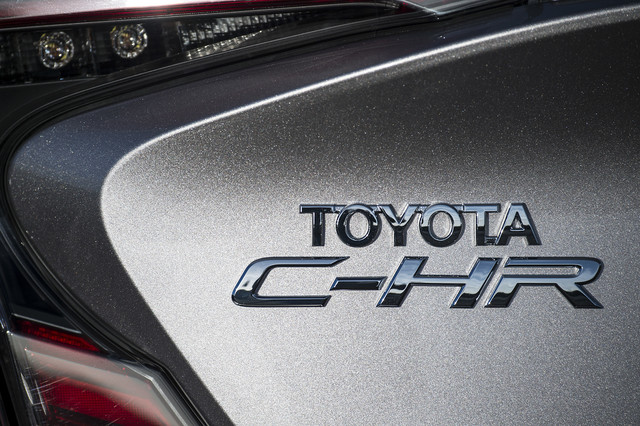
Toyota expects the Hybrid model to claim 70 per cent of UK sales, but we took the 1.2-litre petrol FWD model for a whirl around some twisty roads in Spain to see what the C-HR is made of.
But is the C-HR merely another stylish, jacked-up hatchback?
Performance 4/5
If you're not going for the Hybrid, then the 114bhp 1.2-litre turbocharged petrol is your only engine option. But not to worry, it's a characterful little thing, with 185Nm of torque in its belly and a 0-62 time of 10.9 seconds.
From nudging forward in town traffic to ragging it around mountainous roads, the 1.2-litre is incredibly responsive and, even with the presence of a turbo, smooth to accelerate.
You can choose between either a six-speed manual or a CVT automatic transmission, although the six-speed manual is hands down the one to go for. Not only is it acres smoother than the CVT, but it suits the 1.2-litre's nippy personality perfectly.
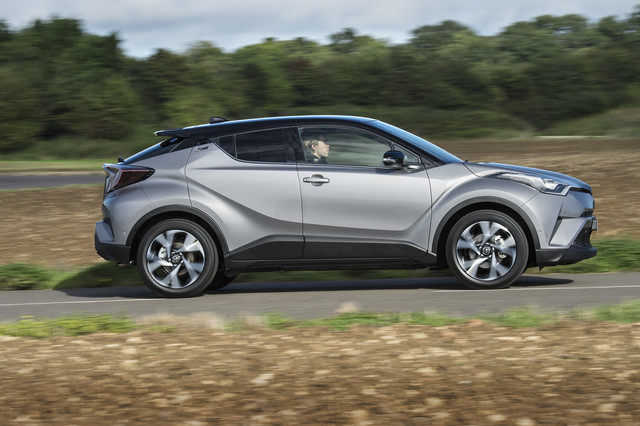
In fact, the manual comes with an Intelligent Manual Transmission system, which ultimately rev matches for you during up shifts and down shifts - a noticeable perk when wanting to shoot out the other side of a hairpin. It also increases available torque when setting off from a standing start.
Toyota has made it clear that it wants the C-HR to be fun to drive, and even with a small 1.2-litre, it manages to deliver.
Ride and handling 4/5
Thankfully, the 1.2-litre has decent underpinnings to channel its power.
The C-HR is quite a light car and you can tell that as soon as you start cornering. Although its ride isn't firm, quite the contrary actually, the C-HR manages to stay planted in the corners. There is minimal body roll, but not enough to put you off flinging it into bends.
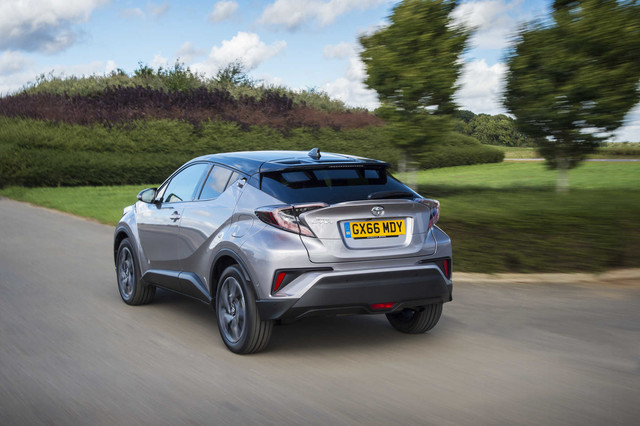
The steering is well-balanced too, with a variable weighting set-up that weights up as you pick up speed, and yet retains its responsiveness. The C-HR certainly gives you more freedom and confidence on twisty roads than the ever-popular Qashqai.
Refinement is fairly good all round, although due to the angular shape of its exterior, there is noticeable wind whistle from the A pillars at motorway speeds. Visibility can be an issue though, as its coupe-like roof leads to a small rear window and chunky C pillars, which in turn leaves you with blind spots.
Interior and Equipment 4.5/5
Similar to its exterior, the C-HR's cabin is almost unchanged from original concept sketches, which for the cabin means a stripped back, minimalistic design. Adorning the dash is a swooping line running from one side to the other, which can be combined with the exterior paint job. Sitting in the centre of the dash is an eight-inch touchscreen system with flush function buttons to either side of it. The air con settings have thankfully been kept as 'proper' buttons underneath the touchscreen for ease of use.
There is also a detailed information screen behind the steering wheel - showing you things like sat-nav directions, mpg figures and G-force details.
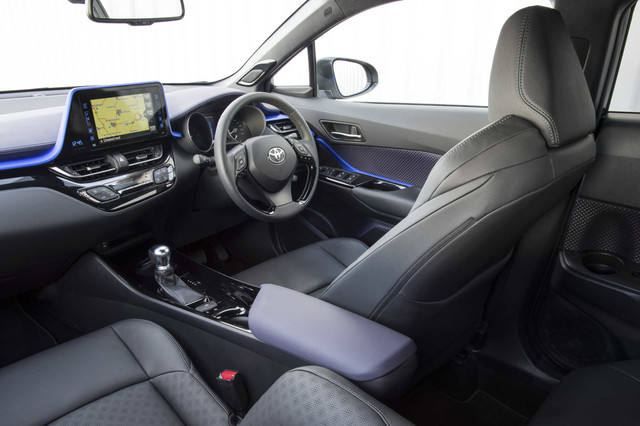
Other design quirks of the youthful cabin include diamond patterns splashed about the place, which feature on the buttons, roof lining and doors, the latter of which looks like a strange futuristic body armour. On the whole, the interior is one of the best Toyota has to offer, with just enough minimalism to make it smart, yet ergonomic.
To match its cool interior is a long list of equipment, particularly safety equipment. There are three trim levels available, of which Toyota claims do not follow any specific hierarchy. However, in price order they are: Icon, Excel and Dynamic.
The Dynamic model we tested came fitted with everything from sat-nav to heated leather seats and 18-inch alloys to a nine-speaker JBL sound system. The extensive safety kit is truly impressive though, with lane keep assist (with steering function), adaptive cruise control, road sign assist, lane departure warning and park assist, to name but a few.
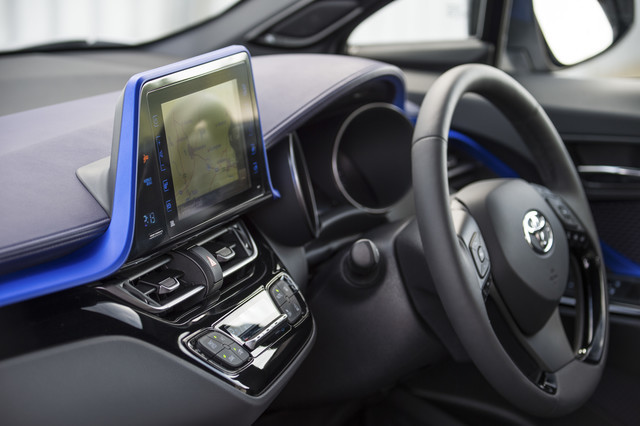
Space in the rear of the C-HR isn't exactly what we would call cramped, but it is snug. Still, compared to many other crossovers - and when you consider its curvaceous exterior - it is still competitive, with enough leg and headroom to keep most happy. A middle passenger is going to be a squeeze though. The cup holders on the door's arm rests are a nice practical touch too.
The boot gives the C-HR a decent competitive edge as well, with 377 litres on offer. There is a rather large boot lip though and the seats don't fold completely flat.
Costs 4/5
Toyota won’t shy away from the fact that the C-HR is a bit pricier than rivals – and with entry-level models from £20,995, it is around £2,500 more expensive than the base Qashqai. Regardless of trim though, the C-HR comes extremely well-equipped. The tech-heavy Dynamic model we tested came out at £25,495.
In terms of efficiency and fuel economy, the 1.2-litre emits 136g/km of CO2 and claims to return an average of 47mpg (18-inch alloys), although you are more likely to get low 40s. The Qashqai does have the leg up on efficiency by offering a diesel option, but for those after low running costs, the C-HR has the Hybrid for that.
And let’s not forget, Toyota has its impressive five year 100,000 mile warranty on its side.
Verdict 4/5
There is an abundance of crossovers on sale, many of which aren't particularly interesting to drive, or necessarily look at. The Toyota C-HR manages to dodge those generalisations, with an intriguing exterior and an agile drive that is clearly the result of a lot of testing and tweaking.
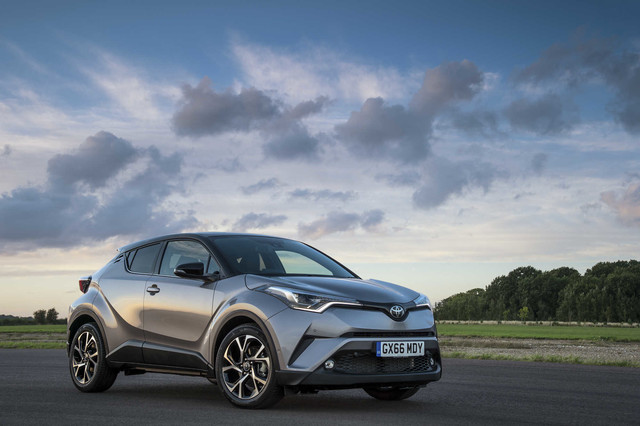
It's not perfect, but it is hard to be perfect in a segment that demands so much criteria, many of which conflict with one another.
The C-HR is certainly one of the crossover market's highlights though, especially for those after funky design and a fun driving experience.
